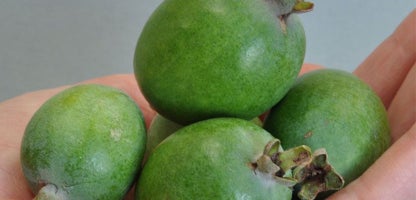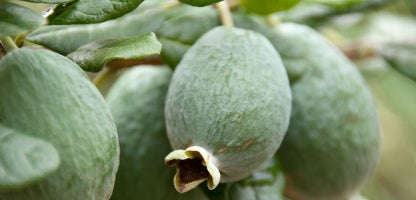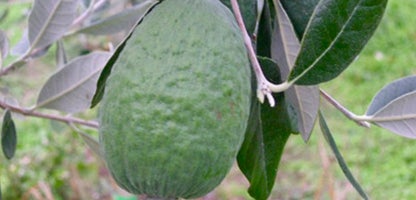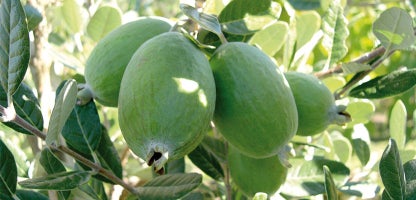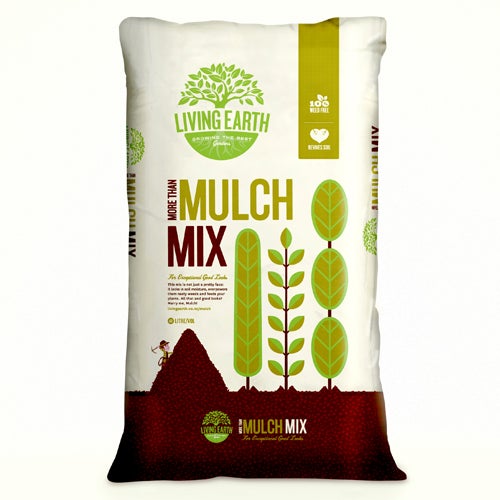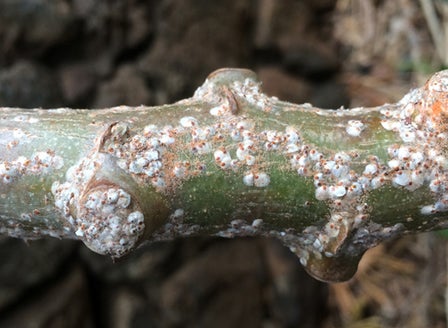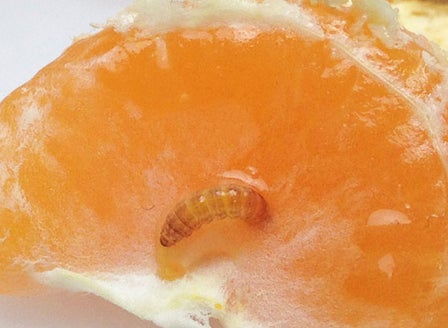Native to southern Brazil and described as a 'pineapple guava', Feijoas are a well-loved fruit in New Zealand, particularly in the North Island. Plant as a feature plant, as a hedge or even in a pot! Sweet, tart, sour, juicy and sometimes even gritty (though not in an unpleasant way) Feijoas can be used in a number of delicious recipes including pies, crumbles, squares, ice creams or even as a fresh addition to your breakfast cereals.
Planting Calendar
Feijoa can be planted throughout the year but do better when planted in Spring and Autumn, giving it time to establish its roots before the heat of summer.
Harvest In
2 - 3 Years
2-3 Years. The fruit is usually harvested between April to June, depending on your variety.
Prepare
Position
Feijoa grow best in full sun to light shade and like a free draining soil rich in organic matter.
Soil
When planted into the ground Feijoa likes a free draining soil that is rich in organic matter. To improve the organic content in your soil, break up the soil and add Kings Compost and Kings Sheep Pellets then mix together well. When growing in containers, plant into Kings Container mix. This mix contains added water storage crystals and Saturaid, two products that help maintain moisture in the soil.
Pollination
There are a few varieties which are self-fertile (such as Unique) but most varieties require a pollinator. Thankfully sorting out a pollinator for Feijoas is easy. All you need to do is grow 2 or more varieties near each other.
Plant
When planting into the ground, gently tap the plant out of its pot. Dig a hole twice the depth and width of the plants root ball. Mix Kings Compost into your existing soil at a 50/50 ratio, add Sheep Pellets and Kings Citrus & Fruit Tree fertiliser, then mix together. Back fill the hole with this soil, so that when planted the top of the plant’s roots sit level with the surrounding ground. Firm the soil down gently and water in well with Aquaticus Organic Garden Booster. In heavier clay soils, where drainage is likely to be an issue, plant onto a raised mound and sprinkle Gypsum Clay Breaker into the bottom of the hole, this helps slowly condition the soil and help to break down the clay. When planting into containers plant into Kings Containers mix, as this has water retention crystals in it, which will help in keeping the soil moist.
Care
Beginner Tip
The 'Sellowiana' type Feijoas are seed-grown Feijoas which usually produce smaller fruit that can be more on the sour side. However, they are great if you want to create a medium-sized hedge or help pollinate other varieties. The other types are cutting grown, and have larger, sweeter fruit.
Tip
Planting multiple varieties that fruit at different times is a good way to ensure a continued supply of feijoas for longer.
Top Varieties
Frequently Asked Questions
How do I prune my feijoa tree?
Feijoa fruit on new growth, so a good prune annually after fruiting will be beneficial. Prune out any damaged or weak branches to open the tree up to allow sunlight and air movement to get amongst the branches. If you have an old overgrown tree, you can prune it down hard as Feijoa sprout back readily.
How often should I water my feijoa tree?
Feijoas are considered hardy and can tolerate small periods of dryness. However, a stressed tree is unlikely to fruit well. Watering is essential especially in the first year of planting to allow the roots to get well established. Water slowly allowing the water to sink down into the roots, rather than allowing it to run off the top of the soils surface. Add Saturaid into the soil at planting as this will help channel the water deep down into the root zone. Consider setting up an automatic watering system – these can be simple and inexpensive.
How much sunlight do feijoa trees need?
Feijoa grow best in full sun to light shade and like a free draining soil rich in organic matter.
What is the best time to plant feijoas?
The best time to plant feijoas is in late autumn or early spring. This allows the roots to establish before the heat of summer or the cold of winter.
How can I tell when feijoas are ready to harvest?
After 2-3 Years. The fruit is usually harvested between April to June, depending on your variety. You can also gently shake the tree; ripe fruit will drop. The fruit should be slightly soft to the touch.
